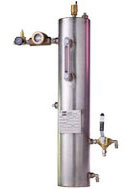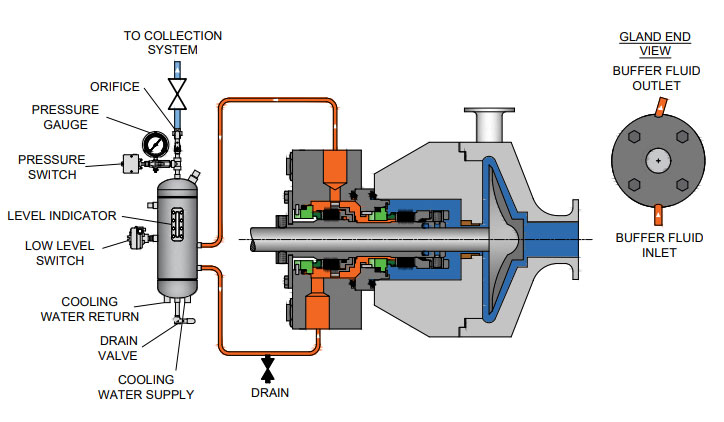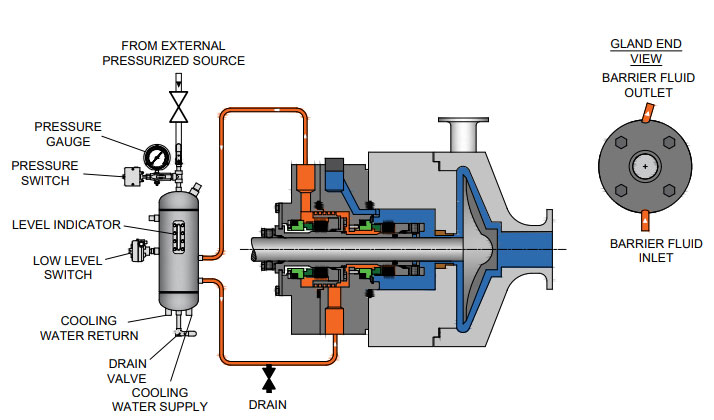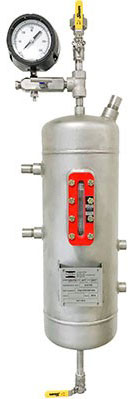Mechanical seal failure due to unfavorable operating conditions is an issue in every industry. Double mechanical seals especially require proper sealing accessories to create suitable operating environments which are key to increasing MTBF. Reservoir systems are one of the most common and effective options to supply cooling fluid crucial to successful seal operation.
In this article, we will explore two types of reservoir systems designed to work with a dual seal configuration.
Defining a Double Mechanical Seal
A double -or dual – cartridge seal is defined as an arrangement of two mechanical seals in a series. These seals may be configured in various orientations within the cartridge. The seals themselves are referred to as the “primary” (or inboard) seal and the “secondary” (or outboard) seal. A double seal arrangement is the superior option to a single cartridge when it is imperative the product being pumped does not leak into the atmosphere. The API (American Petroleum Institute) Standard 682 classifies dual seals into two configurations. These configurations also apply to ASME (American Society of Engineers) B73.1 and ASME B73.2 pump designs.
Arrangement 2 (Unpressurized) Designs: the buffer fluid is the operating environment for the secondary seal and forms a “buffer” between the process fluid and the atmosphere.
Arrangement 3 (Pressurized) Designs: the barrier fluid is the operating environment for both the inboard and outboard seal, preventing process leakage to the atmosphere.
Buffer and barrier fluids may be either liquid or gas. These fluids lubricate seal faces during operation as well as regulate operating temperatures by moving heat—both generated and absorbed—away from the faces.
Seal Support Systems to Promote the Effective Operation of Double Mechanical Seals
Seal support systems are necessary for the smooth operation of a dual mechanical seal. Here are two of the most common piping plans for these systems.
API 682 Plan 52
This is an unpressurized system consisting of a reservoir, supply and return lines, and an internal circulation device within the outer seal (commonly referred to as a pumping ring). The buffer fluid circulation rate is dependent on how this circulation device functions during seal operation.
Reservoirs may be fitted with a variety of measurement devices such as a liquid level indicator and pressure gauges as well as valves and switches to aid in various operation and maintenance functions. For instance, a typical support system configuration for natural gas liquids (NGL) would issue an alarm (visual, audible, or both) when the inner seal fails. In addition, the outer seal would take over the primary seal function until maintenance is performed.
API 682 Plan 53A
This system forces gas from an external pressurized source into the reservoir to pressurize the barrier fluid. This means the reservoir pressure will be above seal chamber pressure; a guideline is a minimum of 20 to 25 psig (1.4 to 1.73 bar) above the maximum process pressure.
The Plan 53A is also used to maintain a specific operating temperature range to ensure optimum lubrication at the seal faces. The reservoir houses a cooling coil which actively cools the barrier fluid as necessary.
As with the Plan 52, a circulation device is used to move the barrier fluid. Replenishing a Plan 53A system with fresh barrier fluid can be as simple as a using a hand pump or a more complex arrangement which satisfies multiple seals.
Buffer and Barrier Fluids: Some Important Properties to Consider
- Safe — environmentally and physically — for operators to use and store
- Not volatile or flammable; stable at ambient temperatures
- Good lubrication and flow values
- Compatible with the process fluid and the seal materials of construction—important to consider for start-up, operating, and upset conditions
- Inexpensive and readily available
Buffer and Barrier Fluid General CategoriesWater and glycol-based solutions
-
- Water and glycol-based solutions
- Low viscosity hydraulic oils: petroleum-based or synthetic
- Heat transfer fluids
- & 5. Fuels such as diesel or kerosene, and alcohol solutions may also we used, but it is imperative that these fuels be evaluated for safety and compatibility before put into service.
Seal Support System Options from Flexaseal
Liquid-lubricated dual mechanical seals require an external source of clean, cool lubricating fluid. The following fluid reservoir systems create this enhanced sealing environment, enabling longer operational life for dual seals.

ANSI LITE Seal Support System
Standard Option: 304L stainless steel
API 682 Plan 52 / ANSI 7352– Used with Unpressurized Buffer Fluid
API 682 Plan 53 / ANSI 7353A– Used with Pressurized Barrier Fluid
- Closed loop arrangement allows monitoring of inboard seal
- Tank with aluminum tubular level gauge
- ½” NPT bronze vent & drain ball valves
- 304L stainless steel orifice union (Plan 52 arrangement)
- 2½” dial 316L stainless steel pressure gauge (0-200 psi)
Learn more and download specifications here
ANSI PLUS Seal Support System
Standard Option: 304L stainless steel
- Stainless steel orifice union (Plan 52 arrangements)
- Reservoir supplied with vent and drain valves
- Multi-port block and bleed valve for easy instrumentation maintenance
Additional Options:
- 4½” 0–400 psig pressure gauge
- Level switch
- Pressure switch
- ½” cooling coils
- Transducers
- Powder-coated stand
- 316L and Carbon Steel tank construction also available
Learn more and download specifications here
In the oil and gas industry, reliable seal operation is critical to running efficient, safe processes. In conjunction with API 682 Piping Plans 52 and 53A, seal support systems aid in smooth seal operation.
If you require an engineered seal support system or are interested in additional options to Flexaseal’s ANSI PLUS and ANSI LITE support systems, please contact our applications engineering team.



